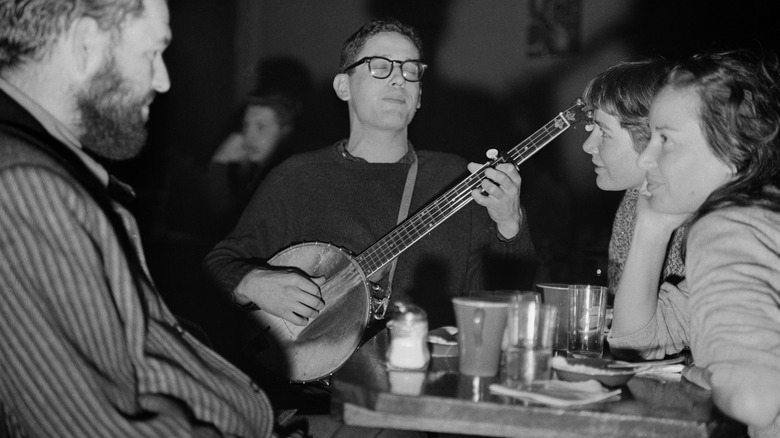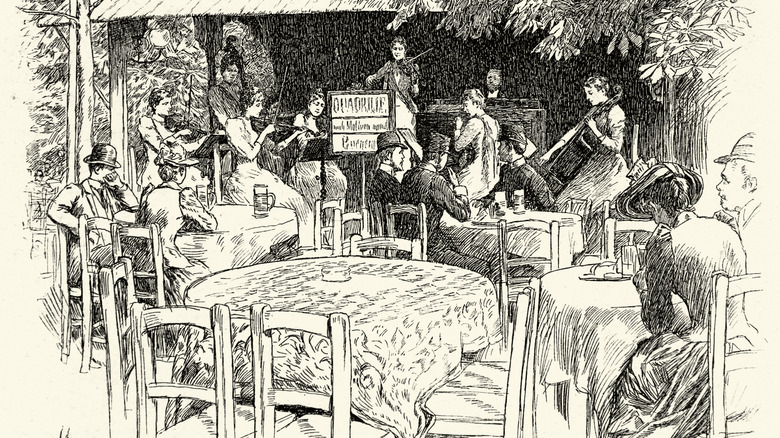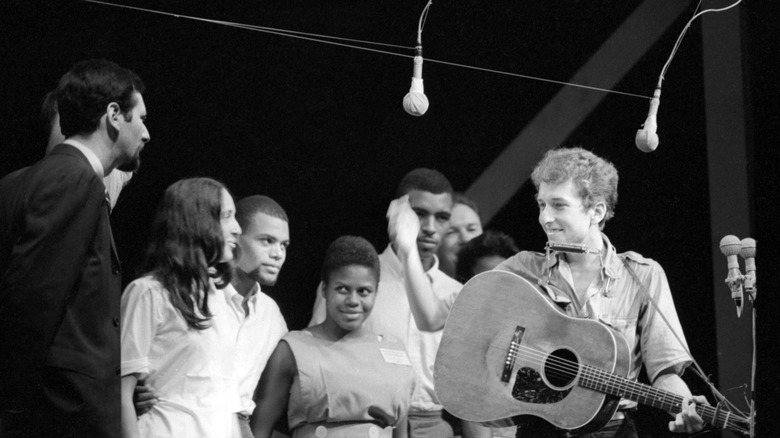How Folk Music Came To Be Associated With Coffeehouses
Walk into your favorite local coffeehouse on a weekend and it's likely that there is a small 3-piece band or duet on a tiny stage singing sweet tunes while playing acoustic instruments and hand percussion. Posters might be hung advertising next week's musical performer beside signs for this week's favorite coffee flavor. This symbiotic relationship between music and coffee is so common that we often don't stop to question how the two became joined at the proverbial hip. Even worldwide coffee chains such as Starbucks highlight music and feature artists.
Both coffee shops and folk music share a rich historical past that highlights the lifestyle and plight of "common" folk. Coffeehouses' rise to modern popularity coincided with folk music's rise to popularity. Coffeehouses were often located in community buildings or churches, writes Undiscovered Music. Equally, folk music was the music of the common people, not the elite, explains Study.com. Together they represented a movement that today we recognize only as a common practice.
Coffeehouses can be traced to the 1500s
The first coffee shop can be traced back to the early 1500s in Constantinople, according to the Library of Congress. Because Muslim belief prohibits alcohol consumption, coffeehouses grew to be the watering holes of early civilization in the East. As imports expanded, coffee became popular in Europe, writes Coffee Affection. Because they were sober cafes, interactions in them turned to discussions of politics, community events, and were sought out by businessmen for connection and transaction, as opposed to rowdy taverns, writes Driftaway. But, with the exchange of information and business also comes the exchange of "misinformation". History explains that kings in England and Germany tried to outlaw or ban coffee and the spread of political opinions within coffeehouses during the Enlightenment and into the 17th century.
The United States also saw the rise of coffeehouses. Coffee was once thought of as a "patriotic drink" when America was declaring its independence from England. As the United States grew and progressed, coffeehouses remained a place of business. Even the New York Stock exchange was started in Tontine Coffeehouse on Manhattan's Wall Street. During the 1950s and 60s Italian immigrants encouraged the growth of coffeehouses with fancy espresso machines, which promoted an atmosphere of progressive thinking.
Folk music is the people's music
Progressive thinking came through strongly in the lyrics of rising genre, folk music. Folk music comes from the Old English word "folc" which meant "common people", according to Study.com. It was originally meant to describe the music of "uncultured" people, in direct contrast to the elite European classical music. Folk music usually features acoustic instruments and sings about issues that affect common people. Topics like depression, labor work, and class mistreatment are features of folk music. Made popular in America by artists like Woody Guthre and Pete Seeger, folk music was the music of storytelling and folklore, but it soon became political anthems of the people's plight.
If folk music is the people's music, then coffee is the people's drink and coffeehouses became places to sit and listen to the quiet and sincere music of small ensembles while drinking thought-stimulating elixir. Gigs in coffeehouses didn't pay well, according to the Amlicker blog, so the musicians that often played there were more committed to a cause than using songwriting as a means of income. Baskets were passed around to collect money for the performing artist. Like the coffeehouses of the Enlightenment and Renaissance, the coffee houses in 1960s America were places of free expression. The Red Scare drove musicians to perform in them safely, worried that their lyrics could be flagged as Communist, continues Amlicker blog.
Coffeehouses became a place of idea exchange.
Coffeehouses are a conducive environment for listening to music. Warm, intimate, and cozy, they encourage thoughtful interaction and quiet introspection, concludes the Library of Congress. Because folk music traditionally uses acoustic instruments like guitars, lyres, and hand percussion, the two almost belong with each other — a perfect venue for solo musicians playing quieter instruments. Rising musicians who weren't "accomplished" enough to perform in halls, could perform publicly in coffeehouses and be guaranteed an audience. The lack of alcohol also gave coffee shops a "family-friendly" appeal. Music could actually be heard as opposed to raucous jazz or nightclubs.
Then and today, coffeehouses encourage the sharing of ideas, gathering of communities, and expansion of creativity. Forbes writes that coffee shops are the "pillar of our economy" by providing jobs and strengthening the local economy whether by featuring a local roast from ethically sourced beans, featuring the work of a break-out artist, or debuting an up-and-coming musician.



